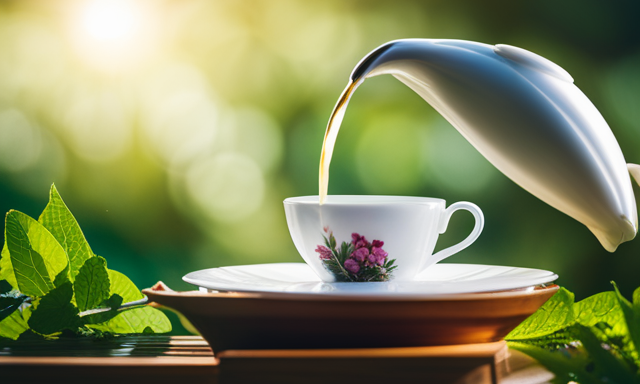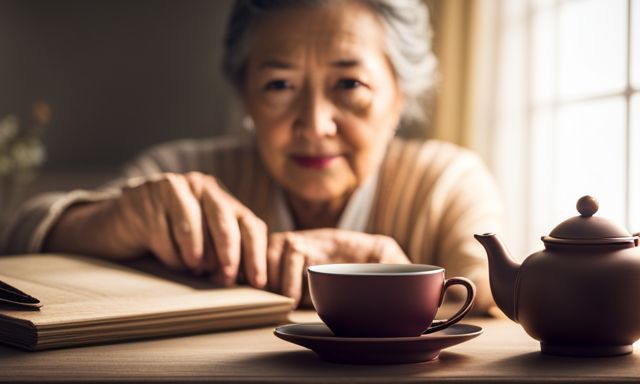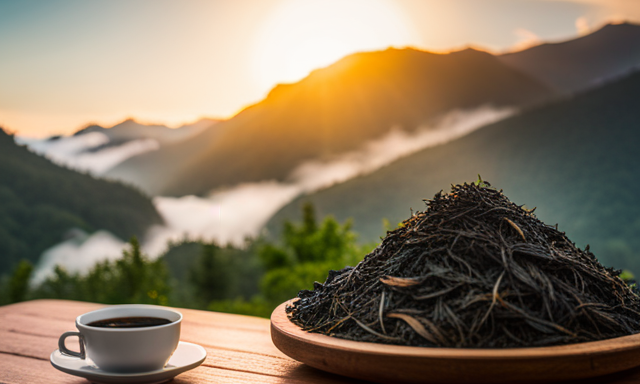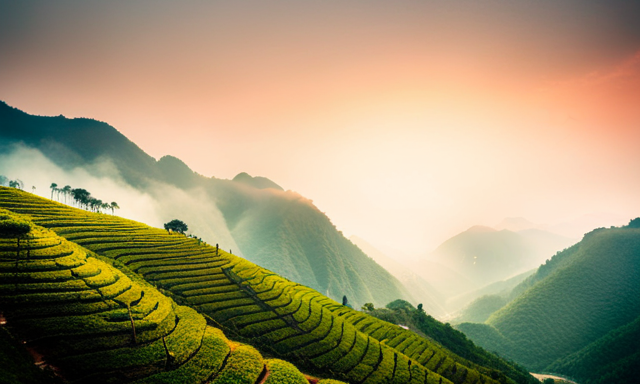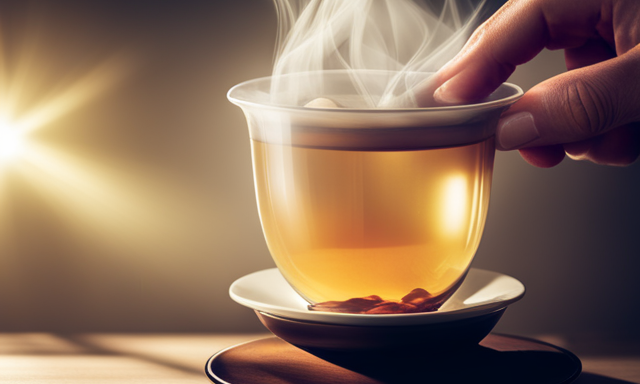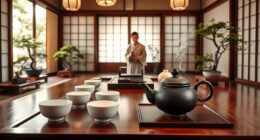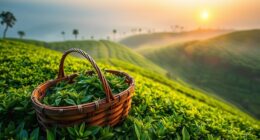I adore a nice cup of tea. There is something incredibly comforting and calming about cradling a steaming mug in my hands, the scent swirling around me like a warm hug.
And when it comes to oolong tea, I can’t resist its rich and complex flavors. But sometimes, I crave a touch of sweetness to balance out the slight bitterness. That’s where sweet oolong tea comes in.
In this article, I will show you how to make the perfect cup of sweet oolong tea, step by step. From gathering the ingredients to choosing the right tea and adding just the right amount of sweetener, I’ll guide you through each and every detail.
So, let’s get started and indulge in the delightful blend of oolong tea and sweetness.
Key Takeaways
- Experiment with different sweeteners to find your preferred flavor for sweet oolong tea.
- Start with a small amount of sweetener and gradually increase to avoid overpowering the natural sweetness of oolong tea.
- Consider using honey, agave syrup, and stevia as healthier alternatives for sweetening oolong tea.
- Enhance the natural sweetness of oolong tea by adding infusions or experimenting with combinations of sweeteners.
Gather Your Ingredients
Now, you’re gonna need to gather all your ingredients for making that delicious sweet oolong tea.
There are various sweeteners you can use to enhance the flavor of your tea. Honey adds a natural sweetness, while brown sugar gives a rich caramel taste. If you prefer a healthier option, try using stevia or agave syrup.
To further enhance the flavor, you can experiment with different herbs and spices. Some popular choices include cinnamon, ginger, and mint. These additions can add depth and complexity to your tea, creating a truly unique blend.
Once you’ve gathered all your ingredients, it’s time to move on to the next step: choosing the right oolong tea.
Choose the Right Oolong Tea
First, you’ll want to select the perfect oolong tea that suits your taste buds and satisfies your tea cravings. Here are four different flavors of oolong tea that you can choose from:
-
Floral: This oolong tea has a delicate and fragrant taste, with notes of flowers like jasmine or orchids. It offers a soothing and calming experience.
-
Fruity: If you prefer a sweeter and refreshing flavor, opt for fruity oolong teas. They can have hints of peach, apple, or citrus, adding a zesty twist to your cup.
-
Roasted: For a more robust and nutty flavor, roasted oolong tea is the way to go. It has a toasty aroma and a rich taste that pairs well with desserts.
-
Smoky: If you enjoy bold and intense flavors, smoky oolong tea is a great choice. It has a distinct smoky taste, similar to a campfire, which adds depth to your tea experience.
Besides the delightful flavors, oolong tea also offers numerous health benefits. It contains antioxidants that promote heart health, aids in weight management, and improves digestion.
Now that you’ve chosen your oolong tea, let’s move on to the next step: boiling the water.
Boil the Water
To prepare your perfect cup of oolong tea, begin by boiling water to the ideal temperature. Choose the right temperature, which is crucial for extracting the full flavors of the tea leaves. For oolong tea, the water temperature should be around 180°F to 190°F (82°C to 88°C). It’s recommended to use filtered water to ensure the best taste because tap water can contain impurities that affect the flavor.
Boil the water in a kettle or pot until it reaches the desired temperature. Be precise with the temperature, as overheating can result in a bitter taste. Once the water is heated to the perfect temperature, you’re ready to move on to the next step of steeping the tea leaves, allowing them to infuse their rich flavors and aromas.
Steep the Tea
Once the water has reached the ideal temperature, you can begin steeping your tea leaves to unlock their full flavors and create a delightful infusion. Steeping oolong tea properly is crucial to achieving the perfect balance of taste and aroma. Here’s how to do it right:
- Add the desired amount of oolong tea leaves to a tea infuser or teapot.
- Pour the hot water over the leaves, allowing them to gently unfurl and release their flavors.
- Let the tea steep for about 3-5 minutes, depending on your preference for strength.
- Keep an eye on the color of the tea. Oolong tea should have a golden hue when properly steeped.
- Taste the tea periodically to ensure it has reached your desired flavor profile.
How long should oolong tea steep for? Generally, 3-5 minutes is recommended, but you can adjust the steeping time based on your personal taste. Once the tea is steeped to perfection, it’s time to move on to the next step: adding sweetener.
Add Sweetener
Now that you’ve unlocked the rich flavors of your perfectly steeped oolong tea, it’s time to add a touch of sweetness to enhance the experience.
There are various types of sweeteners you can use to complement the unique taste of oolong tea. Natural sweeteners like honey or maple syrup add a delicate sweetness without overpowering the tea’s flavor. You can also use stevia or monk fruit sweeteners for a calorie-free option.
When adding sweeteners, it’s important to strike a balance and not overpower the tea with sweetness. Start with a small amount and adjust according to your preference.
Additionally, you can experiment with other flavors to enhance the sweetness, such as adding a dash of vanilla extract or a sprinkle of cinnamon.
Finally, stir well to ensure the sweetener is evenly distributed throughout the tea, enhancing every sip of your sweet oolong infusion.
Stir Well
Ensure that you thoroughly mix the sweetener into your freshly brewed oolong tea by stirring well, allowing the flavors to blend seamlessly.
To stir your tea effectively, you have a few different options. You can use a teaspoon to gently stir in a circular motion, ensuring that the sweetener dissolves evenly throughout the tea. Another method is to use a tea spoon and move it back and forth in a zigzag pattern, which creates a beautiful swirling effect.
Properly stirring your tea has several benefits. Firstly, it ensures that the sweetness is evenly distributed, enhancing the overall taste. Secondly, it helps to dissolve any remaining granules of sweetener, preventing a grainy texture. Lastly, stirring releases the aromatic compounds, intensifying the aroma of your sweet oolong tea.
Now that your tea is well mixed, let it cool before enjoying its delightful flavors.
Let it Cool
Allow the gentle whispers of time to embrace your freshly brewed creation, as it gracefully transitions from a scorching elixir to a tranquil elixir of serenity.
Cooling oolong tea can be done in different ways, depending on your preference. One method is to pour the hot tea over ice cubes, allowing it to cool rapidly while maintaining its flavor. Another way is to let it cool naturally at room temperature, allowing the flavors to develop further.
Cold oolong tea offers many benefits, such as refreshing hydration and a soothing effect on the body. It’s also known for its ability to aid digestion and boost metabolism.
Once your tea has reached the perfect temperature, it’s time to move on to the next step and serve it for you to enjoy its delightful taste and rejuvenating properties.
Serve and Enjoy
Once the oolong tea has cooled to perfection, you can savor its delightful taste and experience the rejuvenating properties it has to offer. Serving and enjoying sweet oolong tea is a true pleasure that can be enhanced with different serving suggestions. Here are some ideas to make your tea experience even more enjoyable:
- Pour the tea over ice for a refreshing iced tea option.
- Add a slice of lemon or a sprig of mint to enhance the flavor.
- Pair it with a light snack like biscuits or fruit for a delightful tea time treat.
- Serve it in a beautiful teapot and matching cups to create an elegant ambiance.
- Share the experience with loved ones and create lasting memories over a cup of sweet oolong tea.
Not only does sweet oolong tea taste amazing, but it also offers several health benefits. Studies have shown that oolong tea can aid in weight management, improve heart health, boost metabolism, and reduce the risk of chronic diseases. So go ahead and savor every sip while enjoying the goodness it brings.
As you’ve learned how to serve and enjoy sweet oolong tea, now it’s time to experiment with variations and discover your favorite flavors.
Experiment with Variations
Try exploring different flavor combinations and infusions to create your own unique oolong tea experience. When it comes to sweetening your tea, there are a variety of options to choose from. You can experiment with different types of sweeteners such as honey, agave syrup, or even stevia for a healthier alternative. Each sweetener will add a distinct flavor profile to your tea, so it’s worth trying different ones to find your favorite. To adjust the sweetness level, start by adding a small amount of sweetener and then gradually increase until you reach your desired taste. Remember, oolong tea has its own natural sweetness, so be mindful not to overpower it. By playing around with different sweeteners and adjusting the sweetness level, you can create a personalized and delicious cup of sweet oolong tea.
| Sweetener | Flavor Profile |
|---|---|
| Honey | Rich and floral |
| Agave Syrup | Smooth and caramel-like |
| Stevia | Sweet with no calories |
| Brown Sugar | Earthy and molasses-like |
| Maple Syrup | Sweet and slightly smoky |
Frequently Asked Questions
How long should I steep the tea for?
Steeping time is crucial for perfecting the flavor of tea. Experimentation is key to finding your desired sweetness level. Adjusting the steeping time allows you to create a balanced and delightful cup of tea.
Can I use any type of sweetener?
Yes, you can use alternative sweeteners in your tea. When choosing between natural and artificial sweeteners, consider their taste and health benefits. Experiment to find the one that suits your preference.
What is the best temperature to boil the water?
The optimal brewing time for sweet oolong tea is affected by water temperature. Boiling the water to around 195-205°F allows the flavors to fully develop, resulting in a balanced and rich flavor profile.
Are there any health benefits to drinking sweet oolong tea?
Drinking sweet oolong tea can bring health benefits. It aids in weight loss by boosting metabolism and promoting fat burning. Additionally, it improves heart health by reducing cholesterol levels and preventing the buildup of plaque in arteries.
Can I reuse the oolong tea leaves for a second infusion?
Yes, you can reuse oolong tea leaves for a second infusion. However, the flavor of the second infusion may be lighter than the first.
Conclusion
In conclusion, making sweet oolong tea is a simple and enjoyable process. By selecting the right oolong tea and adding the perfect amount of sweetener, you can create a delicious and refreshing beverage.
For example, Sarah, a tea enthusiast from California, experimented with adding a splash of honey to her oolong tea and found that it enhanced the natural flavors beautifully.
So go ahead, gather your ingredients, steep your tea, and get ready to savor the delightful taste of sweet oolong tea. Cheers!

